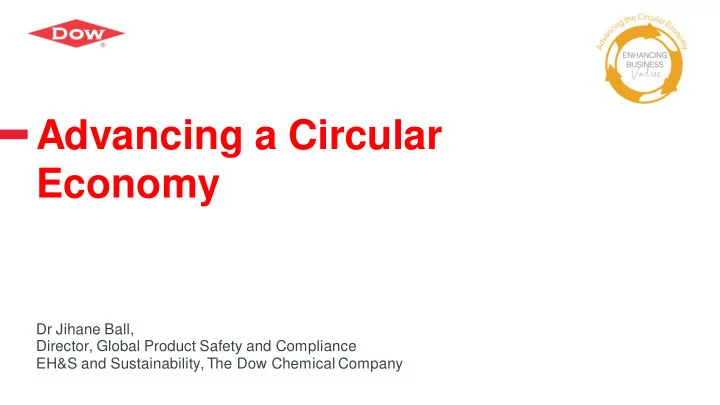

Advancing a Circular Economy Dr Jihane Ball, Director, Global Product Safety and Compliance EH&S and Sustainability, The Dow Chemical Company
Content Some Perspective Dow’s Sustainability Journey Dow’s 2025 Goals and Enabling the UN SDGs The Circularity Gap Circular Economy Policies and Business Models Capturing Opportunities and Navigating Challenges Key Considerations for Recycling and Interface Between Chemical, Product and Waste Legislation Are you Keeping Pace with Change or Anticipating it?
Some Perspective… 70% of buildings that will stand in 2030 are yet to be built in India. By 2025, the predicted urban population of China is 1 billion. Europeans need 2 – 3 planets worth of resources to sustain their current lifestyles. In Europe, 2.7 billion tonnes of waste was generated in 2010 and only 40% was reused, recycled, composted or digested. 50% of all the clothes manufactured globally are never sold or worn.
Population Growth by 2050
Dow’s Sustainability Journey
Dow’s 2025 Sustainability Goals Redefining the Role of Business in Society #DOW2025
2025 Sustainability Leading the Blueprint Delivering Dow leads in developing a societal blueprint Breakthrough Goals that integrates public policy solutions, Innovations science and technology, and value chain Dow delivers breakthrough sustainable innovation to facilitate the transition to a chemistry innovations that advance the well sustainable planet and society. being of humanity. Advancing a Circular Economy Valuing Nature Safe Chemistry for a Sustainable Dow advances a Circular Economy by Dow applies a business decision process Planet delivering solutions to close the resource that values nature, which will deliver Dow increases confidence in the safe use loops in key markets. business value and natural capital value of chemical technology through through projects that are good for the transparency, dialogue, unprecedented company and better for ecosystems. collaboration, research, and our own actions. Engaging for Impact: Communities, World-Leading Operations Employees, Customers Performance Dow people worldwide directly apply their Dow maintains world-leading operations performance in natural resource efficiency, passion and expertise to advance the well environment, health, and safety. being of people and the planet. 7
The Circularity Gap Value of products, materials and resources maintained in the economy for as long as possible & waste generation minimized circular – a massive circularity gap! Today, the world is only 9.1% Closing the loop would: help achieve the UN SDGs and climate policy targets reduce raw material extraction prolong material value in the chain reduce/eliminate waste (by using waste as a resource) reduce incineration, landfilling and dispersion into the environment prevent accelerated environmental degradation and social inequality (The Circularity Gap Report, 2018)
Alignment to UN SDGs
Circular Economy Policies Circular Economy policies emerging in several regions: EU Circular Economy Package UK 25-Year Environment Plan Priority Sectors Policies in China Emerging policies in Canada Rising trends worldwide Response to: Marine debris NGO pressure Societal expectations
Circular Economy Business Models 1. Circular supplies 2. Resource recovery 3. Product life extension 4. Sharing platforms 5. Product as a service Ref. “ C ircular Advantage” Accenture Strategy, 2014
Closing the Loop on Water: Dow Terneuzen Circular Economy solutions for a water stressed Breakthrough Public-Private Partnership region enables Municipal Wastewater to be used 3X 1. Water used by city of Terneuzen 2. City wastewater used to generate High Pressure Steam for the Dow site 3. Water reused again for Cooling Towers and then evaporated
The Ellen MacArthur Foundation | Renault Renault – a leader in the efficient use and reuse of materials • Research projects to enhance the quality of recycled materials and reintroduce into the supply chain • Established closed loops by acquiring shares in dismantling and recycling companies • Launched a repair service using second-hand parts (checked and guaranteed) from end of life vehicles • Has remanufactured mechanical parts since 1949 in a dedicated plant (current turnover > € 200 million) A vehicle requires a large quantity of high-value materials and is a product designed to last and be repaired. An ideal product for remanufacturing and reengineering during its life cycle.
Sharing Platforms “UBER” for Bicycles Dockless Bike-sharing in China
Fashion as a Service-Oriented Business Why Involve the customer and minimize Hack the take-make-waste model overconsumption: Keep your textiles in the loop We wear 20% of our clothes 80% of Rethink the definition of ownership the time. Go for a more service-oriented business While clothes take back and recycling A second life at the on-line marketplace schemes (e.g. H&M, Pantagonia, M&S) are increasing, most of the discarded Think about the impact of your marketing clothes today end up in landfills. Curated Filippa K’s online shop helps clients select Wardrobe timeless and high-quality pieces, and provides information on maintenance Repair service Nudie Jeans free repair shops ‘Made -to- Involve the client in the making of the measure’ and product. Tailoring à la carte Back to the past but less exclusive?
Capturing Opportunities Opportunity Capture: Material Footprint by Sector Environmentally attractive products Meeting customer and market demands Demand for recycled materials Improved reputation Housing & Infrastructure Nutrition Mobility Consumables Services Healthcare Communication (The Circularity Gap Report, 2018)
Navigating Challenges Challenges: Infrastructure Substance restrictions and phase out/REACH Interface between chemical, product and waste legislation (CPW) Coordinating value chains and addressing calls for full compositional disclosures Consumer behavior Stranded assets Compliance Obligations: Fees on products Taxes on resource use and waste
Four Major Issues CPW Issues CPW Actions Defining, tracking and restricting Insufficient Information Substances of Concern Level playing field between Presence of Substances of primary/secondary materials and Concern EU/non-EU articles Difficulties applying End-of- Design for circularity and closer Waste Criteria cooperation Difficulties applying EU waste Harmonized classification system Chemicals Product classification Waste
Are you Keeping Pace with Change or Anticipating it?
Recommend
More recommend